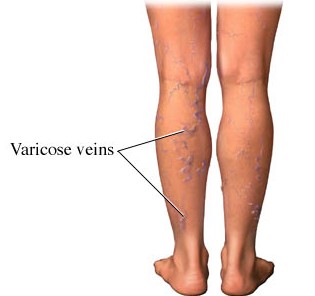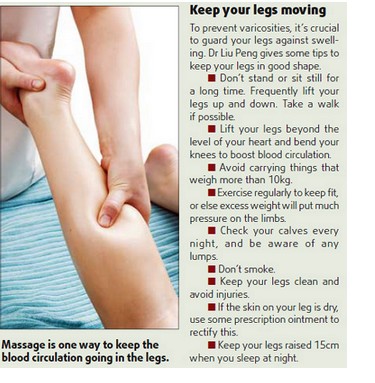
Varicose Veins:
Prevention and Treatment
By
Dr. Paavo Airola N.D., Ph.D.
(Excerpts from his book "Dr. Airola's Practical Guide to Holistic
Health")
Varicose veins affect many women's lives, not only physically,
but also emotionally. Although men are affected by varicose veins,
this condition is far more common among women. Also, men are less
concerned about the aesthetic aspect of varicose veins since it
is easier for them to keep their unsightly veins covered. The purpose of veins is to drain the capillary beds and body tissues
of "used" blood and return it to the heart. Venous blood from
the head and neck returns to the heart by the force of gravity.
But from the legs, venous blood must be moved up against the force
of gravity with the help of the rhythmic sucking action of breathing,
muscular contractions of the extremities, and the valves located
in both the deep femoral and superficial saphenous veins. The
valves prevent the back flow and provide an indispensable "lift"
to the upwards moving blood.
Key products for Varicose Veins

Note from Four Winds Nutrition: All products below might give you more energy when used at the right time and will certainly be beneficial to those who suffer with varicose veins!
1.
Liver Cleanse Formula
Always a good idea to cleanse the liver several times a year.
2. Tiao He Cleanse
A gentle yet very efficient cleanse targeting the intestinal and digestive systems. (To be used at least once a year if not after each holiday such as New-Year, Easter, Labor day)
3. Gentle move
For those who are not "regular" with at least 1 bowel movement a day!
A varicose vein is one in which the valvular system has broken
down, and when one valve breaks or weakens, the next valve is
put under pressure and becomes subject to breakage or weakening,
and so on. This is why varicose veins tend to increase in number
as time goes on. When the valves no longer prevent back flow of
the venous blood, the abnormal pressure dilates the superficial
veins, causing stagnation and pooling of the blood. This results
in permanently dilated veins, which are not only unsightly, but
also painful.
It is estimated that one out of seven adults in North America
has varicose veins. By contrast, the condition is rare-virtually
unknown-in "primitive" countries where people eat more natural,
fiber-rich diets and live more physically active lives.
Which brings us to the causes of varicose veins.
Constipation
 One of the major causes of varicose veins is chronic constipation-another
of our national epidemics. Constipation contributes to the development
of varicose veins in two ways:
One of the major causes of varicose veins is chronic constipation-another
of our national epidemics. Constipation contributes to the development
of varicose veins in two ways:
(1) overloaded bowels press against the veins in the lower abdomen
year after year, gradually breaking down the valves in the veins
and allowing a reverse flow of blood.
(2) constant straining at stools increases pressure in veins and
breaks the resistance in the blood vessel walls. Exercising extreme
pressure in the bathroom is perhaps the main contributing factor.
The return of the blood from the veins of the legs is blocked
almost completely by heavy straining in the bathroom and tremendous
pressure builds up in the veins of the legs. Over the course of
many years this back-up of pressure contributes in a large part
to the development of varicosities. |
The major causes of constipation are: faulty diet of refined foods
and lack of dietary fiber; the lack of sufficient exercise; excessive
meat in the diet (meat is virtually fiberfree); lack of sufficient
liquids; and vitamin and mineral deficiencies.
Liver malfunction
Some authorities consider the breakdown in the proper function
of the liver to be a contributing cause of varicose veins. A swollen,
enlarged, or fatty liver slows down the return of blood to the
heart. Dr. Alan Nittler has successfully treated varicose veins,
even in pregnant women, by using a liver cleansing program in
conjunction with a nutritional supportive program to improve the
function of the liver.
Vitamin E deficiency
A prolonged vitamin E deficiency has been linked to the development
of varicose veins. Supplementing the diet with vitamin E has brought
dramatic improvement in many cases. This vitamin helps prevent
the formation of blood clots and, at the same time, helps to dilate
blood vessels. Vitamin E also helps to dissolve or prevent the
formation of fibrin, a material that makes the formation of blood
clots possible. Thus, vitamin E can play a role in prevention
of varicose veins.
Varicose veins frequently appear during pregnancy,
a time when the requirement for vitamin E is unusually high, and
when there is a surplus of natural estrogen in the system.
An excess of estrogen may contribute to the development of blood
clots, and vitamin E can lower the excessive estrogen.
Dr. Richard A. Passwater conducted an interesting study among
the readers of Prevention magazine, who were asked to comment
on their experience with vitamin E and the heart. Many readers
(158 persons) sent unsolicited comments about their experiences
with the beneficial effect of vitamin E on varicose veins. Not
only had vitamin E eliminated the pain of varicose veins, but,
in many cases, the varicosities completely disappeared, or at
least greatly improved.
Many American women are chronically vitamin E deficient, partly
because the diet of refined foods supplies an inadequate amount
of this important vitamin, and partly because many women take
synthetic iron supplements on a regular basis and vitamin E is
often destroyed in the body by iron supplements.
Lack of exercise
Physical inactivity in combination with too much standing or sitting
is one of the major contributing causes of varicose veins, especially
when combined with the causes mentioned earlier. Varicose veins
are largely a circulation problem. Regular exercise will improve
circulation and prevent too much venous blood collecting in the
lower extremities and creating undue pressure. Drs. Eric P. Lofgren
and Karl A. Lofgren, of the Mayo Clinic in Rochester, Minnesota,
say that "exercise of the leg muscles, particularly the calf muscles,
is essential for normal function of the musculovenous pumping
against gravitational forces."
They add that regular walking can lower the venous pressure to
about one-third that of the pressure during the standing position.
What
can you do?
First, you must recognize that prevention of varicose veins is
much easier than a cure. If an effective preventive program is
instituted early, varicose veins will not develop. Nutritional
deficiencies and the wrong diet of fiberless refined foods must
be corrected.
A regular program of' exercise, even "simple" exercise
such as walking, can help prevent varicosities. If you adhere
to the Optimum Diet (as recommended in Chapters 3 and 4 of Dr. Aviola's Practical Guide to Holistic
Health), take all the supplements recommended, especially E and
C with bioflavonoids, avoid too much sitting or standing, and
exercise regularly, you can be reasonably sure that you will not
be troubled by varicose veins.
What can you do to improve or correct the condition
if' it has already developed?
Here are several suggestions that will help:
1. Optimum nutrition is essential.
Emphasis should be on whole grains, seeds, nuts, vegetables, and
fruits, up to 80 percent eaten raw. Especially beneficial grains
for varicose veins are buckwheat (as in kasha) and millet. This
is a diet rich in natural fiber and will help prevent or correct
varicose veins.
2. Avoid constipation, one of the major causes of varicose veins.
If constipation is your case, start a cleansing program with Tiao He Cleanse followed by Gentle Move for maintenance.
3. Avoid too much sitting, and too much standing (such as at work
where either sitting or standing for the whole day is required).
Studies at Auckland Medical School showed that prolonged sitting
in chairs is one of the main contributing causes of varicose veins.
Sitting with crossed legs is especially dangerous.
4. Avoid tight clothing, especially clothing with tight bands
on the edges as on panties, stocking, girdles, etc. Anything that
constricts the venous return high up can contribute to varicose
veins.
5. A slant board is a very good help for varicose veins. Lie head
down on a slant board and do some leg exercises two or three times
a day.
6. The foot of your bed should be elevated slightly-3 to 4 inches.
7. Walking and swimming are the best exercises for varicose veins.
One to two hours of walking daily should be your goal.
 8. The following few simple exercises, which can be done even
while sitting at the desk, can help prevent varicose veins:
8. The following few simple exercises, which can be done even
while sitting at the desk, can help prevent varicose veins:
a) Flex the ankles up and down 10 to 15 times each;
b) Extend the knee horizontally and bring it back into a right-angle position, also 10 to 15 times each. Repeat the exercises, one after the other, every 30 minutes, if possible. Dr. Charles A. Hufnagel, (former) chairman of the surgery department at the Georgetown University School of Medicine, in Washington, D.C., says that such exercises "prevent the pooling of the blood in the veins, and accelerate the return of the blood out of the veins."
9. Take the following vitamins and supplements daily:
** E-600 to 1200 I.U. mixed tocopherols (increases elasticity of
blood vessels and prevents clots).
** C-up to 3,000 mg. (strengthens the integrity of blood vessels
and improves their elasticity).
** Rutin-500 mg. (European research indicates that rutin and other
bioflavonoids can help reduce the symptoms of varicose veins as
well as reduce blood pressure.)
** B-complex, high potency (helps to revitalize the liver which is
often sluggish and overworked in those who suffer from varicose
veins).
** Zinc-50 mg. (speeds the healing of affected blood vessels).
** Brewer's yeast-2 to 3 tbsp. of powder, taken in pineapple juice
(brewer's yeast is the best natural source of B-vitamins, high
quality
proteins, and important minerals, especially selenium and zinc,
which are of specific benefit for those suffering from varicose
veins).
** Lecithin-2 tsp. of granules (prevents fat accumulation in the
blood vessels and improves circulation).
Wheat germ (must be fresh) - 2 to 3 tbsp. a day (a good source
of B vitamins and vitamin E).
** Multiple vitamin-mineral formula.
10. Take 1 or 2 cloves of garlic every day or, if you object to
garlic odor, take odorless garlic preparations such as NSP Garlic
High Potency (note from Webnat). Garlic helps to dissolve fibrin
in blood vessels and improves circulation.
11. Surgery is not a solution for varicose veins. When varicose
veins are corrected surgically, without correcting the underlying
causes for their development, they usually reappear in a relatively
short time.
12. Using elastic supportive stockings may be advisable in severe
cases. Elastic support garments do help to promote the brisk movement
of blood through the veins and strengthen the muscle tone of the
calf. Especially in severe cases, at least initially, the wearing
of supportive garments could be combined with walking.
13. A vigorous daily dry brush massage, which is an easy and enjoyable
self-treatment can be very helpful,
especially in mild cases of the condition. Dry brush massage is
also an excellent preventive measure against varicose
|